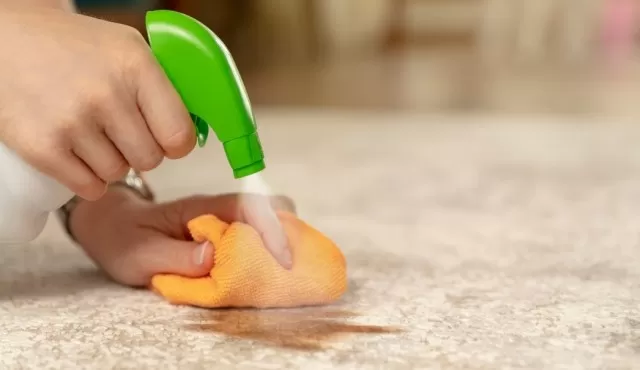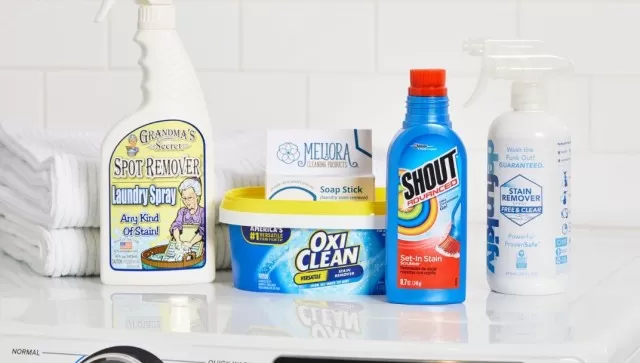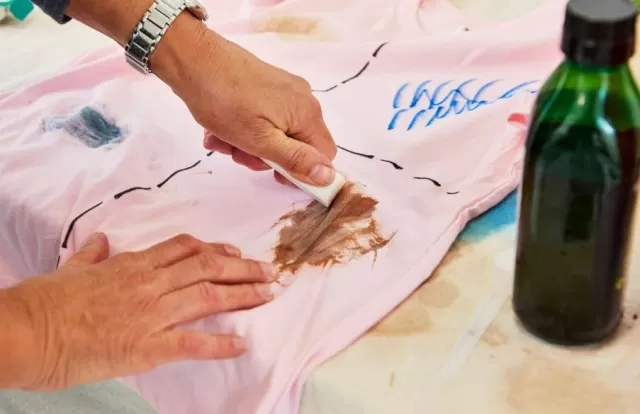Stains are an inevitable part of life, but they don’t have to spell the end for your cherished clothing and fabrics.
A safety reminder

When using liquid ammonia alongside another cleaner, always ensure that the other product does not contain bleach.
The combination of ammonia and bleach can generate a highly toxic gas that poses severe health risks.
Equipped with the right stain removers, you can salvage your favorite items even when accidents occur.
Whether it’s a grease mark, paint splatter, or even a rust stain, the right tools can help you bid these stubborn spots farewell. It’s a good idea to have these stain-removing essentials on hand in your laundry area to swiftly combat marks and blemishes on clothing and linens as they arise.
Always adhere to the usage instructions provided on the product label and make sure to store these items on higher shelves or securely locked upper cabinets, away from the grasp of children.
Also, avoid leaving any of these products atop your washing machine or dryer, as any drips can potentially damage the surfaces of these appliances. Before applying any stain-removing product, consider testing it on an inconspicuous part of the fabric to ensure compatibility.
Here are some of the top-notch stain-removal products that should be a staple in your laundry arsenal.
Stain Removers for Clothes, Linens, and Upholstery Fabric

Chlorine Bleach and Color-Safe Bleach.
Diluted household bleach stands out as one of the most potent stain removers for both clothes and linens.
Always follow the garment’s care instructions when using bleach. When appropriately diluted, bleach is safe for fabrics such as cotton, linen, rayon, and synthetic materials like nylon and polyester.
However, for colored items, opt for color-safe bleach ($8, available at Target) to prevent any unwanted discoloration.
Color Remover.
Color-removal products ($5, available on Amazon) come to the rescue when colors bleed onto lighter fabrics or stain other items during the laundry process.
Unlike bleaches, color removers, like those from Rit ($5, available on Amazon), are formulated to eliminate dye stains without causing harm to the fabric. They are sometimes employed to lighten a garment’s color before redyeing.
These products usually contain ingredients like sodium hydrosulfite or sodium carbonate anhydrous. Keep in mind to address transfer stains or discoloration before subjecting the garment to drying or ironing, as heat can often set the color.
Dry-cleaning fluid or Petroleum-Base Pretreatment Solvent.
Specifically tailored for stains resulting from grease, gasoline, or other petroleum-based substances, petroleum-based solvents like K2r Spotlifter ($13, available on Amazon) are available in various forms such as sticks, gels, squeeze bottles, pump sprays, and aerosol sprays.
Some pretreatment spot lifters are formulated with detergent or surfactant bases rather than solvents. Dry-cleaning fluids ($10, available on Amazon) are another option for addressing stains from ballpoint ink, candle wax, crayons, eye makeup, lipstick, and tar.
A word of caution: Common dry-cleaning fluids often contain substances like perchloroethylene or trichloroethylene, which can be highly flammable.
It’s vital to use them only as directed.
Mild Dishwashing Detergent.
For hand-washing stained fabrics, mild dishwashing liquid (not dishwasher detergent) can be incredibly useful.
Some dishwashing liquids have the ability to break down grease and separate it from the fabric. They can also effectively tackle Food Stains, including those from fruits.
You can even mix dishwashing liquid with glycerin in a ratio of 1/4 cup each, combined with 1-1/2 cups of water, to create a versatile stain-removing mixture.
Nonsudsing Household Ammonia.
Non-sudsing ammonia, commonly used for cleaning glass surfaces, is an excellent choice for stains with odors like urine or sweat, as well as fatty or greasy stains.
For most fabrics, it’s recommended to dilute the ammonia with an equal amount of water. Non-sudsing ammonia can also be used on wool and silk.
However, caution is advised when using ammonia on garments containing latex, as it can dissolve latex fibers.

Paint Remover.
When dealing with Paint Stains, it’s crucial to select the appropriate paint remover based on the type of paint responsible for the blemish.
For latex paints: Address the affected area while the stain is still wet.
Immersing it in cold water can be helpful in eliminating water-based latex paint stains. For more stubborn stains, you can turn to latex-specific spot removers ($10, available at The Home Depot) designed to target and remove these marks effectively.
For oil-based paints: Handle the stain promptly while it remains wet.
Employ a paint thinner ($16, available at The Home Depot) recommended for the particular type of paint. Utilizing petroleum-based solvents as a preliminary treatment before washing can also prove effective in stain removal.
Petroleum Jelly.
When confronted with clothes tainted by water-based glues or adhesives, petroleum jelly emerges as a remarkable stain remover.
By gently massaging petroleum jelly ($2, obtainable at Target) into the adhesive spot, you can weaken its adherence to the fabric. Afterward, rinse the fabric and reapply the jelly until every trace of the adhesive is eradicated.
Subsequent to this, a thorough wash in hot water is recommended. Additionally, petroleum jelly serves as a protective barrier during ink stain treatments, preventing the ink from spreading to neighboring threads.
Furthermore, it can be beneficial in dealing with lipstick stains through careful blotting.
Prewash Spot Removers.
Prewash spot removers are specifically formulated to tackle stains prior to the laundering process.
These removers employ diverse mechanisms to combat stains effectively. They may incorporate cleaning agents or surfactants that loosen the grip of stains, facilitating their removal during washing.
Enzymes are adept at breaking down protein-based stains like blood, rendering them more susceptible to regular laundry detergents. Other types of pretreatments adjust the pH of stains to a more alkaline level, enhancing their susceptibility to cleaning, while pretreatment bleach aids in restoring whiteness to garments.
These versatile prewash products are available in various forms such as aerosols, sprays, sticks, liquids, gels, foams, powders, or wipes.
Some are designed exclusively for use in the laundry room, while others are convenient to carry, allowing for immediate stain intervention while you’re on the go, like the Tide To Go Stain Remover Pen ($3, accessible at Target).
Rust Removers.
Tackling rust stains can be particularly challenging.
As with many other stains, it’s crucial to address the stain promptly and prevent it from setting. Avoid subjecting the fabric to heat, including using a dryer.
However, keep in mind that most rust removers are best suited for white or colorfast fabrics.
A word of caution: Many rust-removing products, like the Whink stain remover ($15, available on Amazon), contain oxalic or hydrofluoric acids, which are toxic substances.
Thoroughly rinsing the fabric after treatment is vital as these products suspend iron-oxide particles in water, and these particles can pose toxicity risks.
White Vinegar.
Ordinary white vinegar proves to be an invaluable ally in the laundry room, offering an array of solutions for various stain-related predicaments.
Consider these handy vinegar-based recipes to keep at your disposal for combatting specific stains:.
Collar rings: Create a mixture of 1/4 cup salt, 1 cup vinegar, and 3 quarts of warm water.
Soak the stained garment in this solution for about an hour.
Cough syrup stains: Prepare a solution by combining 1 quart of warm water, 1/2 teaspoon of liquid dishwashing detergent, and 1 tablespoon of white vinegar.
Soak the stain for 15-30 minutes, then rinse and launder as usual.
Salt stains: Mix 1 part vinegar with 3 parts water and dip a cloth into the solution for wiping away salt stains from shoes and leather garments.
Urine stains on mattresses: Sponge the affected area with a mixture of water and detergent, followed by rinsing with a blend of vinegar and water.
Allow it to dry, and if any odor persists, sprinkle baking soda over the area and let it sit for 24 hours. Once the mattress is dry, vacuum away the baking soda, leaving the mattress refreshed.
*The information is for reference only.